The CEO of Barrick Gold Corp. says “every box has been ticked” when it comes to a list of goals set when the Toronto-based company merged with Randgold Resources Ltd. in a US$6.1-billion all-stock deal early this year.
On a conference call from London, CEO Mark Bristow said Wednesday the company has accomplished much in the past 10 months but more remains to be done.
“That stated aim of the new Barrick was to create the world’s most valued mining company and in the process set an example of modern mining business for an industry in need of invigoration,” he said.
“And there’s no better time to talk about this because, really, everyone dislikes mining, but it’s a absolute core component of everyday life and we as miners have a big challenge to get accepted by the communities and the investors as well.”
Bristow headed Randgold, which was listed in London, prior to the merger, and said returning to London for a board meeting and earnings conference calls fulfills a commitment made at the time of the merger.
Barrick said Wednesday it would raise its quarterly dividend by a penny to a nickel per share as it reported a third-quarter profit boosted by a one-time gain related to its Turquoise Ridge mine, which is part of its Nevada Gold Mines joint venture with Newmont Goldcorp Corp. struck last spring.
The company, which keeps its books in U.S. dollars, forecast of annual synergy savings of US$450 million to US$500 million when it announced the joint venture — Bristow said it has already realized US$311 million and will reach its goal by early 2020.
Production from the joint venture was up 26 per cent in the third quarter from the previous quarter, he added, and cost cutting from more efficient operations are expected to allow the venture to increase reserves by more than one million ounces.
Following the merger with Randgold, Barrick cut about 100 head office jobs in Toronto, leaving about 70, as it shifted towards a decentralized management model.
The company is now reducing the workforce at Hemlo in northwestern Ontario, its only remaining operating gold mine in Canada, after considering shutting it down, Bristow said.
“At the time of the Barrick-Randgold merger, there was some debate about Hemlo’s viability but the anticipated performance improvements are now expected to secure its future,” he said on the call.
Last week, Barrick said it would phase out the open pit operation at the 34-year-old mine and move to a “contract mining model” at its underground works.
It said it is inviting most of its employees working underground to participate in a “voluntary separation program” without saying how many people would be laid off.
In an email Wednesday, a Barrick spokeswoman said further details would be provided when they are available.
The mine on the north shore of Lake Superior, 350 kilometres east of Thunder Bay, has produced more than 21 million ounces of gold. In a 2017 report on its website, Barrick said the mine had 442 employees and between 150 and 200 contractors.
Barrick reported Wednesday it earned nearly US$2.28 billion or $1.30 per share in the quarter ended Sept. 30, up from a loss of $412 million or 35 cents per share a year ago.
Revenue totalled $2.68 billion, up from $1.84 billion in the same quarter last year before the Randgold merger. its realized gold price was $1,476 per ounce, up from $1,216 in the same quarter last year.
On an adjusted basis, Barrick said it earned $264 million or 15 cents per share in its most recent quarter compared with an adjusted profit of $89 million or eight cents per share in the same quarter last year.
Analysts on average had expected a profit of 11 cents per share on $2.82 billion in revenue in the three months ended Sept. 30, according to financial markets data firm Refinitiv.
